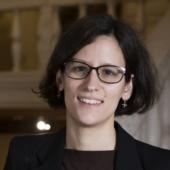Livia Bartók-Pártay
Associate Professor in Computational Chemistry
 Livia Bartók-Pártay is a theoretical chemist, using a range of computer simulation tools to model atomistic and molecular system, studying their structural and thermodynamic behaviour on the atomistic level. She is interested in developing novel computational techniques for studying phase transitions and predicting stable crystalline structures, both in clusters and in condensed phases, using classical interatomic potential models. She also works on modelling systems of nanochemical interest: surfaces and interfaces, adsorption phenomena and aggregation behaviour, focusing on characterising surface particles at the liquid/vapour interface in molecular dynamics simulations.
Livia Bartók-Pártay is a theoretical chemist, using a range of computer simulation tools to model atomistic and molecular system, studying their structural and thermodynamic behaviour on the atomistic level. She is interested in developing novel computational techniques for studying phase transitions and predicting stable crystalline structures, both in clusters and in condensed phases, using classical interatomic potential models. She also works on modelling systems of nanochemical interest: surfaces and interfaces, adsorption phenomena and aggregation behaviour, focusing on characterising surface particles at the liquid/vapour interface in molecular dynamics simulations.
livia dot bartok-partay at warwick dot ac dot uk
024 765 73334
Office G201a
Groups at Warwick
Biography
- October 2019– Assistant Professor, Department of Chemistry, University of Warwick, Coventry, UK and January 2020 - EPSRC Early Career Fellow
- August 2016–September 2019 Dorothy Hodgkin Research Fellow of the Royal Society, Department of Chemistry, University of Reading, Reading, UK
- October 2014–July 2016 Dorothy Hodgkin Research Fellow of the Royal Society, Department of Chemistry, University of Cambridge, Cambridge, UK
- October 2009–September 2014, Junior Research Fellow, St Catharine’s College, Cambridge, UK
- August 2008–April 2009, Eötvös scholarship, University of Cambridge, Cambridge, UK. Working with Prof. David Wales at the Department of Chemistry and Prof. Gábor Csányi at the Engineering Department
- July–August 2007, HPC-Europa scholarship, EPCC, Edinburgh, UK
- 2009 PhD in Chemistry, Eötvös Loránd University, Budapest, Hungary. ‘Colloid chemical applications of computer simulation methods’, Supervisor: Dr Pál Jedlovszky.
- MSc in Chemistry. 2006, Eötvös Loránd University University, Budapest, Hungary. ‘Computer simulation of the aggergation behaviour of bile acid salts in aqueous solution’ Supervisor: Dr Pál Jedlovszky.
- 2001–2006 Eötvös Loránd University University, Budapest, Hungary.
Prizes/Awards
2008 L’Oreal-UNESCO Award For Women in Science (Hungary)
2005 Scholarship of the Hungarian Republic
2005 Pro Scientia Gold Medal
Currently I am working on studying phase transitions in a range of different systems:
- Model systems to tackle exotic phase behaviour, such as liquid-liquid transitions
- Solid order-disorder transitions in technologically important alloys
- Different crystalline structures of Calcium-carbonate
I’m interested in developing novel computational techniques for studying matter on the atomistic level, and especially interested in techniques to sample the potential energy landscape: predict the ground state structure, thermodynamically important local minima structures and locate phase transitions.
I teach part of the fourth year optional module, "Advanced Computational Chemistry".
I have two openings for funded PhD projects in my group, starting in October 2020:
Recent Publications
- Thermodynamics and the Potential Energy Landscape: Case Study of Small Water Clusters, Dorrell J, Pártay LB. PHYS. CHEM. CHEM. PHYS., 21, 7305 (2019)
- Direct computation of the quantum partition function by path-integral nested sampling, Szekeres B, Pártay LB, Mátyus E. J. CHEM. THEORY. COMP., 14, 4353 (2018)
- Thermodynamics of CuPt nanoalloys, Rossi K, Pártay LB, Csányi G, Baletto F. SCIENTIFIC REPORTS, 8, 9150 (2018)
- On the performance of interatomic potential models of iron: Comparison of the phase diagrams, Pártay LB. COMP. MAT. SCI. 149, 153-157 (2018)
- Constant-pressure nested sampling with atomistic dynamics, Baldock RJN, Bernstein N, Salerno KM, Pártay LB, Csányi G. PHYS. REV. E 96, 043311 (2017)
- Polytypism in the ground state structure of the Lennard-Jonesium, Pártay LB, Ortner C, Bartók AP, Pickard CJ, Csányi G. PHYS. CHEM. CHEM. PHYS. 19, 19369 (2017)
- Determining pressure-temperature phase diagrams of materials, Baldock RJN, Pártay LB, Bartók AP, Payne MC, Csányi G. PHYS. REV. B 93, 174108 (2016)
- Nested sampling for materials: The case of hard spheres, Pártay LB, Bartók AP, Csányi G. PHYS. REV. E 89, 022302 (2014)
